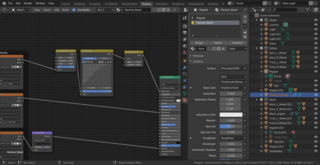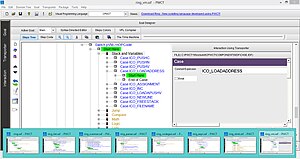
A graphical user interface, or GUI, is a form of user interface that allows users to interact with electronic devices through graphical icons and visual indicators such as secondary notation. In many applications, GUIs are used instead of text-based UIs, which are based on typed command labels or text navigation. GUIs were introduced in reaction to the perceived steep learning curve of command-line interfaces (CLIs), which require commands to be typed on a computer keyboard.
An integrated development environment (IDE) is a software application that provides comprehensive facilities for software development. An IDE normally consists of at least a source-code editor, build automation tools, and a debugger. Some IDEs, such as IntelliJ IDEA, Eclipse and Lazarus contain the necessary compiler, interpreter or both; others, such as SharpDevelop and NetBeans, do not.
In computer programming, event-driven programming is a programming paradigm in which the flow of the program is determined by external events. Typical event can be UI events from mice, keyboards, touchpads and touchscreens, or external sensor inputs, or be programmatically generated from other programs or threads, or network events.

Adobe Authorware was an elearning authoring tool with its own interpreted, flowchart-based, graphical programming language. Authorware was used for creating interactive elearning programs that could integrate a range of multimedia content, particularly electronic educational technology applications. The flowchart model differentiated Authorware from other authoring tools, such as Adobe Flash and Adobe Director, which rely on a visual stage, time-line and script structure.

Max, also known as Max/MSP/Jitter, is a visual programming language for music and multimedia developed and maintained by San Francisco-based software company Cycling '74. Over its more than thirty-year history, it has been used by composers, performers, software designers, researchers, and artists to create recordings, performances, and installations.

Laboratory Virtual Instrument Engineering Workbench (LabVIEW) is a system-design platform and development environment for a visual programming language developed by National Instruments.

Houdini is a 3D animation software application developed by Toronto-based SideFX, who adapted it from the PRISMS suite of procedural generation software tools.

Autodesk Softimage, or simply Softimage was a 3D computer graphics application, for producing 3D computer graphics, 3D modeling, and computer animation. Now owned by Autodesk and formerly titled Softimage|XSI, the software has been predominantly used in the film, video game, and advertising industries for creating computer generated characters, objects, and environments.

Microsoft Robotics Developer Studio is a discontinued Windows-based environment for robot control and simulation that was aimed at academic, hobbyist, and commercial developers and handled a wide variety of robot hardware. It requires a Microsoft Windows 7 operating system or later.

Node graph architecture is a software design structured around the notion of a node graph. Both the source code and the user interface are designed around the editing and composition of atomic functional units. Node graphs are a type of visual programming language.
Pipeline Pilot is a desktop software program sold by Dassault Systèmes for processing and analyzing data. Originally used in the natural sciences, the product's basic ETL and analytics capabilities have broadened over time. The product is now used for data science, ETL, reporting, prediction, and analytics in a number of sectors. The main feature of the program is the ability to design data workflows using a graphical user interface. It is an example of visual and dataflow programming and has use in a variety of settings, such as cheminformatics and QSAR, Next Generation Sequencing, image analysis, and text analytics. It is not an 'object oriented' programming language.
ASU VIPLE is a Visual IoT/Robotics Programming Language Environment developed at Arizona State University.

PWCT is an free open source visual programming language for software development. The project was founded in December 2005 as a free-open source project that supports designing applications through visual programming then generating the source code. The software supports code generation in many textual programming languages.







